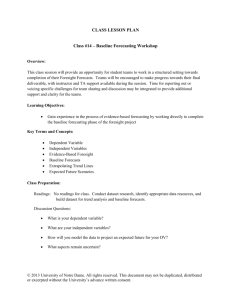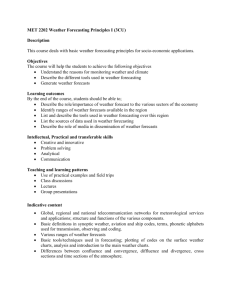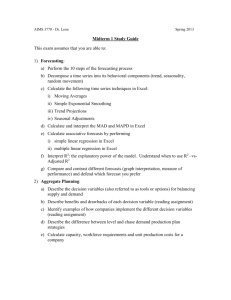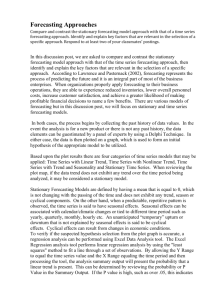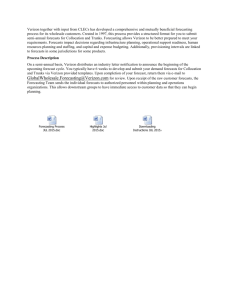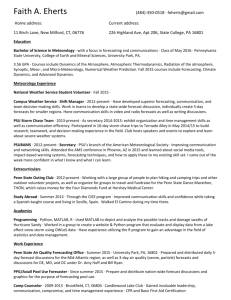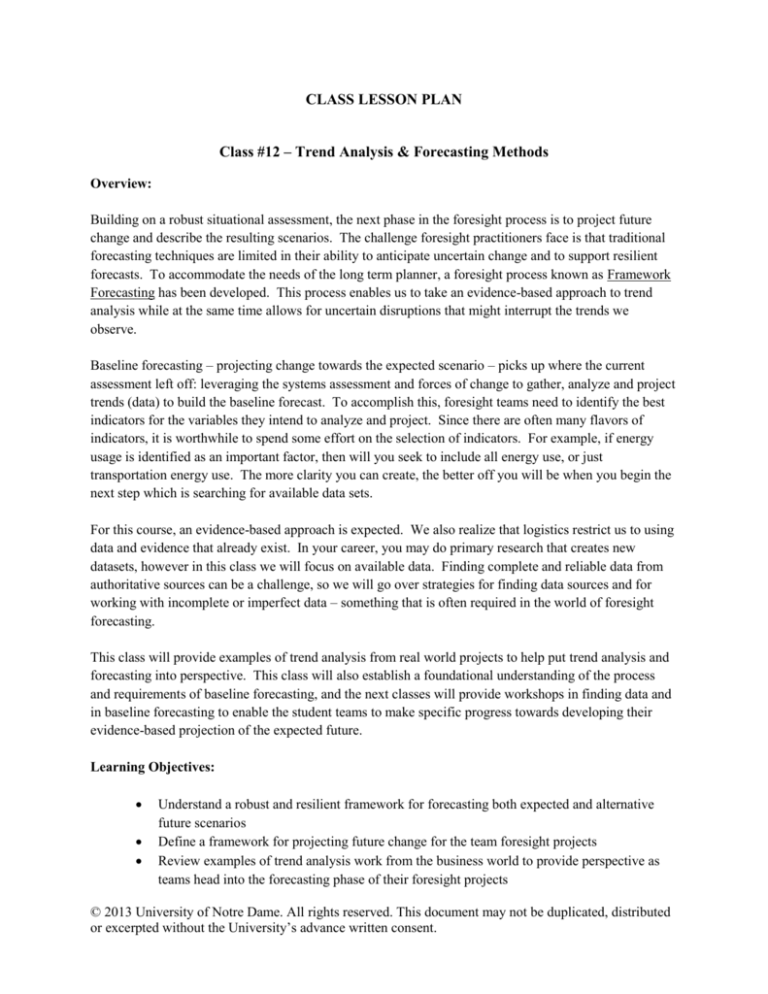
CLASS LESSON PLAN
Class #12 – Trend Analysis & Forecasting Methods
Overview:
Building on a robust situational assessment, the next phase in the foresight process is to project future
change and describe the resulting scenarios. The challenge foresight practitioners face is that traditional
forecasting techniques are limited in their ability to anticipate uncertain change and to support resilient
forecasts. To accommodate the needs of the long term planner, a foresight process known as Framework
Forecasting has been developed. This process enables us to take an evidence-based approach to trend
analysis while at the same time allows for uncertain disruptions that might interrupt the trends we
observe.
Baseline forecasting – projecting change towards the expected scenario – picks up where the current
assessment left off: leveraging the systems assessment and forces of change to gather, analyze and project
trends (data) to build the baseline forecast. To accomplish this, foresight teams need to identify the best
indicators for the variables they intend to analyze and project. Since there are often many flavors of
indicators, it is worthwhile to spend some effort on the selection of indicators. For example, if energy
usage is identified as an important factor, then will you seek to include all energy use, or just
transportation energy use. The more clarity you can create, the better off you will be when you begin the
next step which is searching for available data sets.
For this course, an evidence-based approach is expected. We also realize that logistics restrict us to using
data and evidence that already exist. In your career, you may do primary research that creates new
datasets, however in this class we will focus on available data. Finding complete and reliable data from
authoritative sources can be a challenge, so we will go over strategies for finding data sources and for
working with incomplete or imperfect data – something that is often required in the world of foresight
forecasting.
This class will provide examples of trend analysis from real world projects to help put trend analysis and
forecasting into perspective. This class will also establish a foundational understanding of the process
and requirements of baseline forecasting, and the next classes will provide workshops in finding data and
in baseline forecasting to enable the student teams to make specific progress towards developing their
evidence-based projection of the expected future.
Learning Objectives:
Understand a robust and resilient framework for forecasting both expected and alternative
future scenarios
Define a framework for projecting future change for the team foresight projects
Review examples of trend analysis work from the business world to provide perspective as
teams head into the forecasting phase of their foresight projects
© 2013 University of Notre Dame. All rights reserved. This document may not be duplicated, distributed
or excerpted without the University’s advance written consent.
Key Terms and Concepts:
Framework Forecasting
Baseline Forecasts
Expected Future Scenario
Alternative Future Scenarios
Preferred Future Scenario
Cone/Limit of Plausibility
Trend Extrapolation
Derivative Extrapolation
Assumptions and Logic
Validity
Residual Uncertainty
Discontinuous Events
Directionally Correct
Class Preparation:
Readings:
Bishop, P. (2005). Managing Uncertainty and Influencing the Future. Framework
Forecasting
Discussion Questions:
Given the inevitable unpredictability of the future, what is the value of a baseline forecast?
What are some of the shortcomings of traditional business forecasting as it applies to longer term
projections?
How does the cone of plausibility model help or hinder leaders’ ability to create a view of the
future that is useful in business?
Drivers of change can be categorized as trends, events and issues. Explain how these three
categories align with the findings of your current assessment and how you can use these
distinctions in developing your trend analysis strategy.
What is the value of the cone of plausibility model for your team’s foresight project? Be
prepared to discuss specific strategies and challenges for using this approach to create a view of
the future that will be useful in business decision making.
What is meant by the phrase “surprise-free future”?
Assignment Due:
Trend Analysis Strategy homework due __________________________.
© 2013 University of Notre Dame. All rights reserved. This document may not be duplicated, distributed
or excerpted without the University’s advance written consent.
INSTRUCTOR GUIDELINES
Discussion Questions with Answers:
Given the inevitable unpredictability of the future, what is the value of a baseline forecast?
A: Baseline forecasts are used to provide a well-support project of the surprise-free future – how
the future will unfold if linear change continues uninterrupted into the future (e.g. no disruptions
occur). So the intent is not to declare that surprises will not occur (this is not realistic), but
rather that if no surprises occur, this surprise-free or expected future scenario will unfold.
This expected future scenario, in addition to being the most likely to occur (however slim the
probability is), will also serve as the starting point from which to gauge the impact of
discontinuities that may occur. With a clear understanding of where trends are headed, planners
can more easily determine where the new trajectory may deflect based on a foreseeable
disruption to the trends. The expected future scenario thus can serve as the foundation from
which to project alternative scenarios.
What are some of the shortcomings of traditional business forecasting as it applies to longer term
projections?
A: Traditional forecasting can be very useful in business, especially for more near term needs
such as sales forecasts, cash flow forecasts, and HR needs forecasts. The traditional processes
are not as well suited for longer time horizon assessments like those needed in the foresight
process. Specifically, the shortcomings are:
o
Assume that trends will continue
o
Fail to recognize obstacles
o
Underestimation of the world and its possibilities
How does the cone of plausibility model help or hinder leaders’ ability to create a view of the
future that is useful in business?
A: The cone of plausibility model projects expected, plausible alternative and in some cases
preferred future scenarios. This can be highly useful for decision makers that are facing levels of
uncertainty in their business environment. The multiple scenario approach allows for a range of
plausible outcomes to be envisioned, and can enable development of resilient strategies that can
position businesses for favorable outcomes across a range of scenarios. Defining preferred
outcomes can allow for development of shaping strategies that can influence which future
scenario occurs.
This cone of plausibility method can also lead to indecisiveness. Some planners and researchers
do not favor the method because it can impede decision making and proactive strategies.
© 2013 University of Notre Dame. All rights reserved. This document may not be duplicated, distributed
or excerpted without the University’s advance written consent.
Drivers of change can be categorized as trends, events and issues. Explain how these three
categories align with the findings of your current assessment and how you can use these
distinctions in developing your trend analysis strategy.
A: Trends are those things that behave in a linear or curvilinear (continuous) manner. These
trends can be assessed and based on assumptions of future trajectory can be projected into the
future. These trends can be useful in developing baseline forecasts for your independent and
ultimately your dependent variable to create your expected future scenario.
Events are those occurrences that would cause disruptions in trends. The likelihood of the event
is usually uncertain which means that it cannot be forecasted in the way that a trends can.
Events are often the trigger events that signal one alternative scenario over another.
Issues are those aspects that are often the source of debate and may signal a change in the
likelihood of an event. For example, carbon and climate change are a current issue being
debated. If this issue tended toward resolution, it may provide a signal that an event such as
passage of carbon cap and trade is more or less likely to occur. Issues should be monitored as a
means of sensing weak signals on the likelihood of important potential events.
What is the value of the cone of plausibility model for your team’s foresight project? Be
prepared to discuss specific strategies and challenges for using this approach to create a view of
the future that will be useful in business decision making.
A: The challenge with using a method such as the cone of plausibility is that it can lead to “blue
sky” projections that are vague and not of high value to decision makers. These challenges can
be overcome as the project moves forward. First, making sure that the topic definition (central
question) is crisp rather than vague can help. Creating a well-defined baseline forecasting model
can go a long way towards providing the reader a clear and understandable projection of where
the likely future of the category is headed. Second, developing robust (as opposed to flimsy)
scenarios helps to make them more actionable in decision making.
What is meant by the phrase “surprise-free future”?
A: A surprise-free future projects how the future will unfold if linear change continues
uninterrupted into the future (i.e. no disruptions occur). So the intent is not to declare that
surprises will not occur (this is not realistic), but rather that if no surprises occur, this surprisefree or expected future scenario will unfold.
Class Timeline:
5 Minutes – Quote of the Day and Intro
15 Minutes – Overview of traditional forecasting and foresight forecasting
30 Minutes – Presentation of examples trend projections from industry
20 Minutes - Guidelines and team workshop time for developing a trend analysis strategy
5 Minutes – Wrap Up and Preview of Upcoming Class
© 2013 University of Notre Dame. All rights reserved. This document may not be duplicated, distributed
or excerpted without the University’s advance written consent.
Classroom Activities:
This session will provide examples of three or four different approaches to trend projection that
come from recent reports. Use this section of the class to solicit feedback and comments on
which methods they prefer and why. In addition to the methods used by the various
organizations, get them to observe and comment on the approaches used to communicate the
findings. What type of graphics and tables did the organizations use? What formats were more
effective than others? Get them to start thinking about not only how to develop projections but
also how to effectively use data visualization for impact and clarity.
Multimedia Supplements:
World Future Society Top Ten Forecasts video:
http://www.youtube.com/watch?v=byih4QJTkJM
Trend Projections from industry:
o
o
o
o
U.S. Energy Information Administration, Annual Energy Outlook 2012
http://www.eia.gov/forecasts/aeo/pdf/0383(2012).pdf
Millennium Ecosystem Assessment
http://www.maweb.org/documents/document.356.aspx.pdf
ExxonMobil Energy Outlook 2013
http://www.exxonmobil.com/Corporate/files/news_pub_eo.pdf
Emerging Energy Research: Post-Recession Wind Market Landscape
http://www.emerging-energy.com/Content/Document-Details/Wind/ThePostRecession-Wind-Market-Landscape/800.aspx
Will require that you register (for free) to access the report.
Notes and Perspectives:
Aim to give the students clear perspective on the need for and format of a clear trend analysis
strategy, and give them time at the end of class to work on theirs.
© 2013 University of Notre Dame. All rights reserved. This document may not be duplicated, distributed
or excerpted without the University’s advance written consent.

